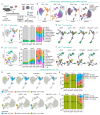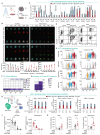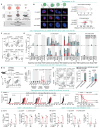In vivo dendritic cell reprogramming for cancer immunotherapy
- PMID: 39236156
- PMCID: PMC7616765
- DOI: 10.1126/science.adn9083
In vivo dendritic cell reprogramming for cancer immunotherapy
Abstract
Immunotherapy can lead to long-term survival for some cancer patients, yet generalized success has been hampered by insufficient antigen presentation and exclusion of immunogenic cells from the tumor microenvironment. Here, we developed an approach to reprogram tumor cells in vivo by adenoviral delivery of the transcription factors PU.1, IRF8, and BATF3, which enabled them to present antigens as type 1 conventional dendritic cells. Reprogrammed tumor cells remodeled their tumor microenvironment, recruited, and expanded polyclonal cytotoxic T cells; induced tumor regressions; and established long-term systemic immunity in multiple mouse melanoma models. In human tumor spheroids and xenografts, reprogramming to immunogenic dendritic-like cells progressed independently of immunosuppression, which usually limits immunotherapy. Our study paves the way for human clinical trials of in vivo immune cell reprogramming for cancer immunotherapy.
Conflict of interest statement
Figures







Comment in
-
Tumour cells get a dendritic cell makeover.Nat Rev Drug Discov. 2024 Nov;23(11):814. doi: 10.1038/d41573-024-00168-3. Nat Rev Drug Discov. 2024. PMID: 39379622 No abstract available.
-
Reprogramming tumor cells to fight cancer.Science. 2024 Oct 18;386(6719):274-275. doi: 10.1126/science.ads6228. Epub 2024 Oct 17. Science. 2024. PMID: 39418388
References
-
- Bawden EG, Wagner T, Schröder J, Effern M, Hinze D, Newland L, Attrill GH, Lee AR, Engel S, Freestone D, de Lima Moreira M, et al. CD4+ T cell immunity against cutaneous melanoma encompasses multifaceted MHC II-dependent responses. Sci Immunol. 2024;9:eadi9517. - PubMed
-
- Larkin J, Chiarion-Sileni V, Gonzalez R, Grob J-J, Rutkowski P, Lao CD, Cowey CL, Schadendorf D, Wagstaff J, Dummer R, Ferrucci PF, et al. Five-year survival with combined nivolumab and ipilimumab in advanced melanoma. N Engl J Med. 2019;381:1535–1546. - PubMed
-
- Adams S, Loi S, Toppmeyer D, Cescon DW, De Laurentiis M, Nanda R, Winer EP, Mukai H, Tamura K, Armstrong A, Liu MC, et al. Pembrolizumab monotherapy for previously untreated, PD-L1-positive, metastatic triple-negative breast cancer: Cohort B of the phase II KEYNOTE-086 study. Ann Oncol. 2019;30:405–411. - PubMed
Publication types
MeSH terms
Substances
Grants and funding
LinkOut - more resources
Full Text Sources
Other Literature Sources
Medical
Molecular Biology Databases

